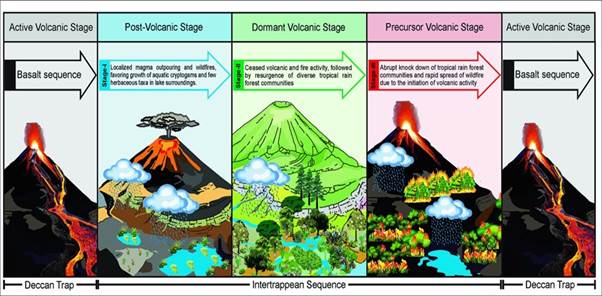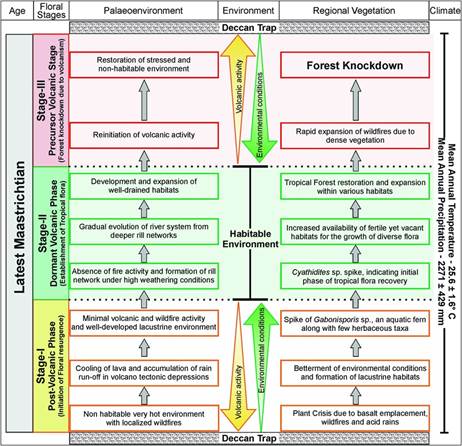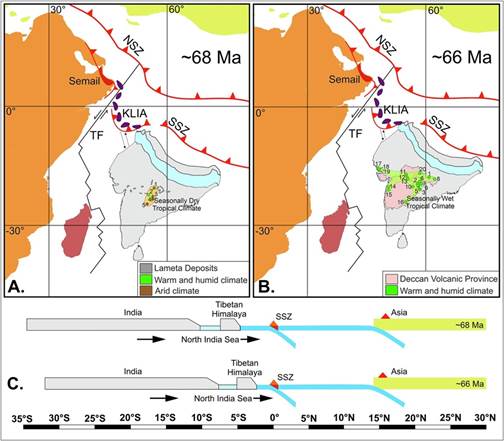Tropical Flora showed significant resilience during the Deccan Volcanism on Indian Plate
Deccan Volcanism, a major event of volcanic eruptions which occurred ~66 million years ago and led to mass extinctions of fauna, did not have such negative impact on tropical flora, says a new study.
Rather the Deccan Volcanism indirectly imposed a positive impact on the development of hyper-diverse tropical flora by wiping off the large faunal community of dinosaurs along with gymnosperms and by providing nascent, undisturbed, barren yet fertile habitats within congenial warm and humid climate state ideal for angiosperms to grow and evolve.
The study raises a hope that, if left undisturbed, our tropical rainforests may quickly recover under favorable climatic conditions.
The Deccan volcanic eruptions continued for several hundred thousand years before and beyond the Cretaceous-Paleogene (K-Pg) boundary, suggesting it was one of triggering agents for the K-Pg mass extinction that culminated ammonoid (invertebrate cephalopods) and dinosaur dynasties on the global scale. Although the impact of this event received intensive scrutiny, its impact on flora remains debated. As the epicenter of Deccan Volcanism, the Indian Plate provides an ideal archetype for identifying any associated floral turnover, if at all, during this time.
A study by Birbal Sahni Institute of Palaeosciences (BSIP), an autonomous institute of Department of Science and Technology, suggests that despite highly devastating consequences for terrestrial faunas (dinosaurs, in particular), the Deccan Volcanism only caused regional and short-term impacts on the flora. Instead, it promoted diversification and expansion of angiosperms within diverse habitats on the Indian Plate. Conclusively, the latitudinal shifting of the Indian Plate within the Inter Tropical Convergent Zone (ITCZ), the formation of a filter corridor between Africa and India and excessive warm and humid climate during dormant phases of Deccan Volcanism instituted the rapid development and diversification rather than extinction in the tropical rainforest community.
The scientists unearthed this by studying pollen, spores and organic matter which they extracted from sedimentary rocks in living and fossil forms. Rock (mudstone and claystone) samples were collected from a 17 m thick sedimentary sequence from Yeotmal area in Maharashtra. Palynomorphs Pollen, spores (palynomorphs) and organic matter (plant debris) were extracted from samples by digesting them with different acids for palynological and palynofacies analyses (study of pollen, spores, organic matter etc in living and fossil forms). Palynology is used for establishing biostratigraphy and reconstructing palaeoecology, palaeoclimate and palaeobiogeography, while, palynofacies studies were used for reconstructing depositional environment. Palaeoecological and palaeoclimatic models based on methods called Nearest Living Relative (NLR) approach and Coexistence Approach (CA) analyses were used in the study. Palaeobiogeographic reconstruction was also undertaken.
The study published in the journal Earth Science Reviews shows that despite the fact that Deccan Volcanism released toxic greenhouse gasses into the environment, causing the K-Pg mass extinction due to rise in global temperatures, the tropical flora recovered swiftly on a sub-millennial scale, indicating higher resilience of tropical flora to climatic stresses. Therefore, understanding floral turnovers brought by geological and climatic upheavals during the geological past may aid in forecasting their responses to the ongoing climatic changes due to global warming.

Figure 1: Simplified palaeovegetational model of floral succession inferred from palynology, palynofacies, NLR and CA for Yeotmal area.

Figure 2: Flow chart of events showing stages of vegetation succession and environmental changes in relation to the Deccan Volcanism.

Fig. 3: (A-B). The planar representation of the palaeogeographic and palaeoclimatic reconstruction, displaying KLIA as a biotic filter corridor connecting north-eastern Africa and northern India (after Rodriguez et al., 2021; Yuan et al., 2022: Geographic coordinates were referred from GPlates). Reconstruction at A. ca. 68 Myr. and B. ca. 66 Myr.. C. Schematic representation of the Indian Plate movement at ca. 68 Myr and 66 Myr. Abbreviations: TF-Transform Fault, NSZ-Northern Subduction Zone, SSZ- Southern Subduction Zone, KLIA-Kohistan-Ladakh Arc, 1- Jabalpur, 2-Nagpur, 3-Nand-Dongargaon, 4- Pisdura, 5-Chandrapur, 6-Chindwara, 7-Mohgaonkalan, 8-Dindori, 9-Nawargaon, 10-Yeotmal, 11-Dhar, 12-Dhangaon, 13-Betul, 14-Raigad, 15-Mahabaleshwar, 16-Naskal, 17-Kutch, 18- Lakshmipur, 19-Anjar, 20-Sagar.
***
NKR/PSM